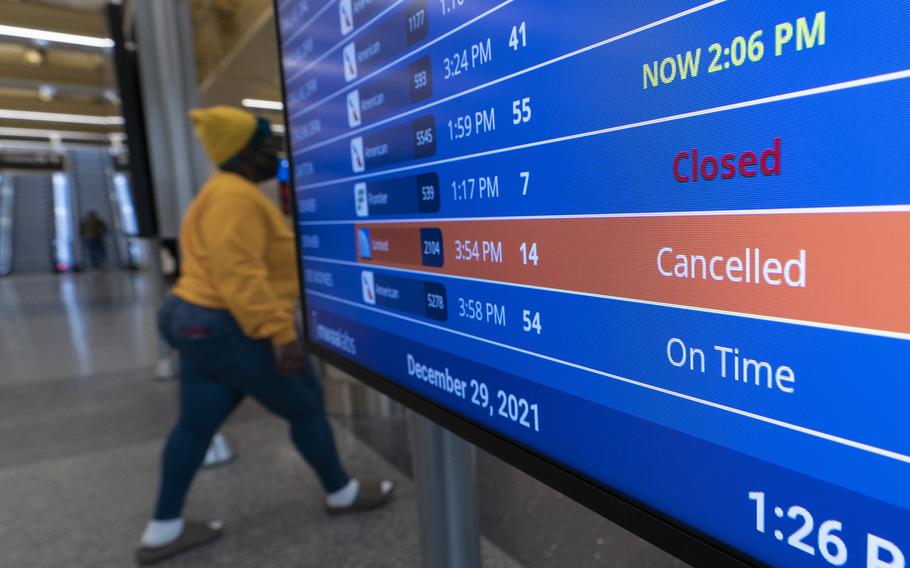
A flight shows cancelled on the departures board at Ronald Reagan Washington National Airport, Wednesday, Dec. 29, 2021, in Arlington, Va. (Alex Brandon/AP)
In the days leading up to Christmas — one of the busiest travel times of the year — two extreme, disruptive and dangerous weather systems will affect large parts of the Lower 48 states: a very intense storm that will produce blinding snow, heavy rain and howling winds, and an associated outbreak of exceptionally cold air.
The large, powerful storm is set to explosively develop in the Midwest and Great Lakes late this week, unleashing heavy snow and strong winds — and the potential for blizzard conditions in some areas.
Possibly qualifying as a “bomb cyclone” because of its projected rapid strengthening, the storm could bring extreme impacts from snow and wind from the Plains to the interior Northeast between Thursday and Christmas Eve, seriously affecting several major population centers including Kansas City, St. Louis, Des Moines, Chicago, Milwaukee and Buffalo.
While not everyone will see heavy snow this week, few areas outside California and the Southwest United States will escape what the National Weather Service is describing as “a massive surge of arctic air.”
Exceptionally cold and windy air will be drawn southeastward from Canada by this potent storm. The cold will seep into Texas — and eventually Florida. Houston could see temperatures in the teens and wind chills near zero Friday morning. On Thursday, subzero temperatures may stretch from Denver to Minneapolis with temperatures 40 to 50 degrees below normal from Montana to the Texas Panhandle.
In some places, this will be the coldest December weather since at least 1989. By the second half of the week, much of the northern Plains, Upper Midwest and Great Lakes will have subzero temperatures — even for highs — with wind chills as low as minus-55 near the Canadian border.
Storm threatens holiday travel boom
More than 112 million people are expected to travel more than 50 or more miles away from home between Dec. 23 and Jan. 2, according to AAA, an increase of 3 percent over last year but still below pre-pandemic numbers.
The bulk of those on the move — estimated at nearly 102 million — will drive, according to AAA. More than 7 million will fly, while several million more will take the train or use other modes of transportation. According to AAA, 2022 is shaping up to be the third-busiest year for holiday travel since it began tracking the numbers in 2000.
But many of those trips could be disrupted by a massive storm that could bring snow and wind to the Rockies and northern Plains beginning Wednesday before moving east. For airlines, which have spent months preparing for one of the busiest travel periods of the year, the timing could not be worse.
The Federal Aviation Administration is expecting Thursday to be the busiest travel day of the week, with 47,554 scheduled flights. On Friday, more than 44,300 flights are scheduled.
Jonathan Porter, AccuWeather’s chief meteorologist, said he thinks as many as 5,000 flights could be delayed or canceled if the storm, as predicted, causes blizzard conditions at airports in Chicago, a major hub for United, and in Detroit, a major hub for Delta Air Lines. The storm also could bring heavy rain and gusty winds to major airports along the I-95 corridor, including Washington Dulles International, Reagan National, Philadelphia, Boston and all New York-area airports.
In anticipation of the storm, many carriers have begun issuing travel waivers that allow passengers to reschedule their flights with no change fees.
“American Airlines continues to monitor Winter Storm Elliott, which is expected to impact airports in the midwestern and northeastern U.S. this week,” the carrier said Tuesday. “Critical to our preparations was sizing the airline for the resources we have available and operating conditions we face.” In hopes of preventing last-minute disruptions, the carrier has issued travel waivers for 57 airports that will allow passengers to rebook without change fees. “We’ll continue monitoring Winter Storm Elliott and make any adjustments to ensure the safety of our customers and team members,” American said.
Highway travel across much of the central and eastern parts of the country could also be affected by the blizzard, and some roads could be closed, Porter said.
Despite continued concerns about the economy, Americans have proved they’re willing to spend on travel, a trend that has fueled record revenue for airlines in 2022. And even as health experts have renewed their push for Americans to get up-to-date on vaccinations in anticipation of another covid-19 winter surge - on top of an early and aggressive flu season and high levels of respiratory syncytial virus (RSV) - people are determined to take advantage of the first holiday season in three years that is free of pandemic-related travel restrictions and mask mandates.
“People do want to travel,” said Sharon Pinkerton, senior vice president for legislative and regulatory policy for Airlines for America, a trade group that represents the nation’s largest airlines. “Something we all know but bears repeating is the pandemic has changed all of us. And one of the changes is that people value experiences over things, and they’re voting with their pocketbooks by getting back to travel.”
After a difficult summer, the Thanksgiving travel period was relatively trouble-free for airlines, aided in part by good weather across the United States, a massive hiring push and lessons learned from the summer. The Transportation Security Administration reported that it screened more than 2.5 million passengers on the Sunday after Thanksgiving - the most in a day since the pandemic began.